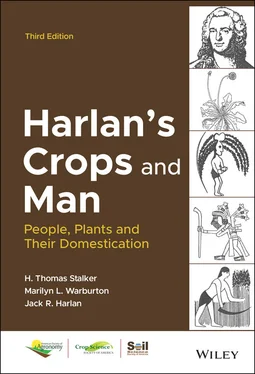An indication of ecological sophistication is reported by Levitt (1981) for Aborigines of Groote Eylandt. Some common grasses were used as “calendar plants”—when grains of Chrysopogon spp. are ripe, it is time to dig yams; or when grains of Heteropogon triticerus R. Br. start to shatter, it is time to dig yams; and when all grains have fallen, it is time to stop. When Heteropogon contortus (L.) P. Beauv. ex Roem. & Schult. begins to flower, the rainy season will soon be over. Other hunter‐gatherers receive similar signals from their knowledge of plant growth and reproduction.
The more one studies the wealth of plant lore of gathering peoples the more one is impressed by the extent and coverage of their botanical knowledge. Man knows what he needs to know or learns what he must or else he dies. The security and stability of gathering economies are from necessity, rooted in an extensive body of information about plants.
Manipulation of Vegatation
Kangaroo Island lies off the south coast of Australia. It had once been inhabited by Aborigines, but they left or died out long before European contact. The woody vegetation had become a virtually impenetrable thicket, while the nearby mainland with the same climate supported an open, grassy woodland. This comparison gives us some understanding of the extent of Aboriginal control over the vegetation. To this day, if areas are uninhabited for an extended period, the woody vegetation thickens up, and the Aborigines find the landscape uncomfortable and spiritually dangerous (Chase, 1989). After repeated burnings, the land again shows the stamp of human occupancy and the Aborigines feel more comfortable and spiritually safe. The Aborigines have more or less domesticated the landscape by skillful use of fire and complain that the white man lets the land get “dirty” (Lewis, 1989). Jones (1969) called it “firestick farming.”
The Aborigines did more than clear land by burning. They diverted water to flood forests in the dry season: “We like to see plenty of water in the jungle all the time, for birds of all kinds gather near it, and the food plants that we like grow better” (Campbell, 1965). They constructed water‐spreading devices for the rainy season (Lourandos, 1980), and they ditched to increase the supply of eels and other fish (Walters, 1989). In the course of digging up wild root crops, they churned up large areas to the point they resembled plowed fields. Sir George Grey wrote (1841):
In the Province of Victoria, as already stated, I have seen tracts of land several square miles in extent, so thickly studded with holes, where the natives have been digging up yams ( Dioscorea ) that it was difficult to walk across it. Again, in the sandy desert country which surrounds for many miles, the town of Perth, in Western Australia, the different species of Haemadorum are very plentiful.
The borderline between gathering and farming becomes very hazy at this point. Douglas Yen referred to such activities as Aboriginal agronomy (Yen, 1989). Perhaps the key difference here between foraging and farming is that no native Australian plant was actually domesticated, otherwise hunter‐gatherers do about everything farmers do.
The Great Basin Native Americans did about the same, burning vegetation, sowing seeds, and irrigating tracts of land (Downs, 1964). Indeed, fire was used to modify vegetation just about anywhere that vegetation could be burned, and the practice may well have gone back to Acheulean times (Hallam, 1975). There are some immediate returns from the practice; animals fleeing fires are more vulnerable to the spear and the bow, but the major returns are delayed. New shoots, unencumbered by old growth attract grazing animals; the ash provides some fertility for regrowth; heat renders phosphorus more available; woody vegetation is retarded and herbaceous plants increase; wild seed harvests are enhanced; roots and tubers escape injury in the dry season and thrive as competition is reduced. The landscape is tamed, but the plants and animals were not.
Food Plants in Ritual and Ceremony
Some California tribes, heavily dependent on acorns for food, conducted an annual spring ceremony, usually in April, for the purpose of increasing the crop. The participants went out at night, visited specified trees, and implored them to yield abundantly. The trees were supposed to respond (Loeb, 1934).
First‐fruit ceremonies are practiced by the African Bushmen. When the fruit of a certain species begins to ripen at the onset of the big rainy season (usually February), a day is appointed and the women go out and ceremonially gather fruit from previously designated trees. The men stay in camp and all the camp fires are extinguished. When the fruits are brought to camp, a composite sample is carefully selected and presented to a head man, who kindles a special fire and ceremonially appeals to the fire for a plentiful harvest. He then eats the fruit. After the ceremony both men and women can partake of the fruits, but it is offense to eat them before the ceremony (Marshall, 1960).
Among various Bushmen tribes at least simple first‐fruit ceremonies are performed for a dozen or more different plants. Each of the major veld foods (plants in open grasslands of South Africa) has its own choa ceremony (Thomas, 1959). The !Kung observe a first‐fruit ceremony dealing with tubers. The rite is performed by the head man on a selected day. One of the prayers translates: “Father, I come to you, I pray to you, please give me food and all things that I may live” (Schapera, 1951). The tubers must not be touched until the ceremony is performed.
Spencer (1928, 1967) describes, in some detail, yam ceremonies on Melville Island, Australia. These are celebrated as rainy season initiation rites. One particular yam, called Kolamma or Kulemma, has small rootlets (like whiskers) all over it. It is supposed to make whiskers grow on boys and so is involved in growing‐up rites. Girls may be initiated at the same time, but no female can touch the yam or the ceremonial fire until the rites are completed. One of the lines chanted is: “Yams, you are our fathers!” The natives assert that after the ceremony all kinds of yams will grow plentifully.
It might be mentioned here that the New Yam ceremonies are the most important in the ceremonial calendar of yam‐eating tribes of West Africa. It is important not to dig some species of Dioscorea too early in the season and this sound agricultural practice is reinforced by religious ritual. A similar protective ritual is observed by the nonagricultural Andamanese (Coursey, 1972).
The Warramunga tribe of Australia has a yam totem; the Kaitisha tribe has a grass seed totem and celebrates a grass seed dance and ceremony. Rain dances are performed by both Bushmen and Australian natives to increase food resources. These are but a few of the many examples that could be given to show how plants that are important sources of food or well‐being are venerated and intimately woven into the religious and ritual life of gathering peoples.
Much has been made by some social anthropologists of the more or less egalitarian nature of hunter‐gatherer societies. Game brought in by a hunter is shared by usually strict rules; the hunter himself has little to say about it. Produce gathered by the women and children is normally shared by the whole camp. One may own personal items like digging sticks, bows, arrows, spears, boomerangs, carrying nets, bowls, pots, and so forth, but if someone asks for something, it is very difficult to refuse. There is, in many tribes, a sense of community ownership, but this is likely to vary by degrees of relationship. Nearly all items might be shared by the immediate family or even within an extended family, but sharing becomes diluted with more distant relations. Lee (1988) pointed out that there are strong peer pressures to share freely and to prevent an individual from dominating or even showing pride. Egos are continuously being deflated by bawdy jokes and condescending comments.
Читать дальше












